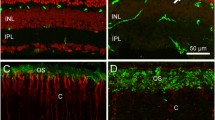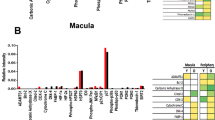Abstract
Age-related macular degeneration (AMD) is a main causes of severe visual impairment in the elderly in industrialized countries. The pathogenesis of this complex diseases is largely unknown, even though clinical characteristics and histopathology are well described. Because several aging changes are identical to those observed in AMD, there appears to exist an unknown switch mechanism from normal ageing to disease. Recent anatomical studies using elegant innovative techniques reveal that there is a 30% rod loss in normal ageing, which is increased in early AMD. Those and other observations by Curcio and co-workers indicate that early rod loss is an important denominator of AMD (Curcio CA. Eye 2001; 15:376). As in retinitis pigmentosa (RP), rods appear to die by apoptosis. Thus it seems mandatory to study the regulation of rod cell death in animal models to unravel possible mechanisms of rod loss in AMD. Our laboratory investigates signal transduction pathways and gene regulation of rod death in our model of light-induced apoptosis. The transcription factor AP1 is essential, whereas other classical pro- and antiapoptotic genes appear to be less important in our model system. Caspase-1 gene expression is distinctly upregulated after light exposure and there are several factors which completely protect against light-induced cell death, such as the anesthetic halothane, dexamethasone and the absence of bleachable rhodopsin during light exposure. A fast rhodopsin regeneration rate increased damage susceptibility. Our data indicate that rhodopsin is essential for the initiation of light-induced rod loss. Following photon absorption, there may be the generation of photochemically active molecules wich then induce the apoptotic death cascade.
Similar content being viewed by others
References
Curcio CA. Photoreceptor topography in ageing and agerelated maculopathy. Eye 2001; 15(Pt 3): 376–83.
Young RW. Pathophysiology of age-related macular degeneration. Surv Ophthalmol 1987; 31(5): 291–306.
Pauleikhoff D, Holz FG. Die altersabhängige Makuladegeneration. Ophthalmology 1996; 93: 299–315.
Eldred GE. Lipofuscin fluorophore inhibits lysosomal protein degradation and may cause early stages of macular degeneration. Gerontology 1995; 41(Suppl 2): 15–28.
Bird AC. What is the future of research in age-related macular disease? Arch Ophthalmol. 1997; 115(10): 1311–3.
Bird AC, Bressler NM, Bressler SB, et al. An international classification and grading system for age-related maculopathy and age-related macular degeneration. The International ARM Epidemiological Study Group. Surv Ophthalmol 1995; 39(5): 367–74.
Kliffen M, van der Schaft TL, Mooy CM, de Jong PT. Morphologic changes in age-related maculopathy. Microsc Res Tech 1997; 36(2): 106–22.
Curcio CA, Sloan KR, Kalina RE, Hendrickson AE. Human photoreceptor topography. J Comp Neurol 1990; 292(4): 497–523.
Curcio CA, Millican CL, Allen KA, Kalina RE. Aging of the human photoreceptor mosaic: evidence for selective vulnerability of rods in central retina. Invest Ophthalmol Vis Sci 1993; 34(12): 3278–96.
Curcio CA, Medeiros NE, Millican CL. Photoreceptor loss in age-related macular degeneration. Invest Ophthalmol Vis Sci 1996; 37(7): 1236–49.
Curcio CA, Owsley C, Jackson GR. Spare the rods, save the cones in aging and age-related maculopathy. Invest Ophthalmol Vis Sci 2000; 41(8): 2015–8.
Owsley C, Jackson GR, White M, Feist R, Edwards D. Delays in rod-mediated dark adaptation in early age-related maculopathy. Ophthalmology 2001; 108: 1196–202.
Naash ML, Peachey NS, Li ZY, et al. Light-induced acceleration of photoreceptor degeneration in transgenic mice expressing mutant rhodopsin. Invest Ophthalmol Vis Sci 1996; 37(5): 775–82.
Cruickshanks KJ, Klein R, Klein BE, Nondahl DM. Sunlight and the 5-year incidence of early age-related maculopathy: the beaver dam eye study. Arch Ophthalmol 2001; 119(2): 246–50.
Reme CE, Grimm C, Hafezi F, Marti A, Wenzel A. Apoptotic cell death in retinal degenerations. Prog Retin Eye Res 1998; 17(4): 443–64.
Reme CE, Grimm C, Hafezi F, Wenzel A, Williams TP. Apoptosis in the retina: the silent death of vision. News Physiol Sci 2000; 15: 120–4.
Williams TP, Howell WL. Action spectrum of retinal lightdamage in albino rats. Invest Ophthalmol Vis Sci 1983; 24(3): 285–7.
Redmond TM, Yu S, Lee E, et al. Rpe65 is necessary for production of 11-cis-vitamin A in the retinal visual cycle. Nat Genet 1998; 20(4)): 344–51.
Grimm C, Wenzel A, Hafezi F, et al. Protection of Rpe65-deficient mice identifies rhodopsin as a mediator of lightinduced retinal degeneration. Nat Genet 2000; 25(1): 63–6.
LaVail MM, Gorrin GM, Repaci MA. Strain differences in sensitivity to light-induced photoreceptor degeneration in albino mice. Curr Eye Res 1987; 6(6): 825–34.
Danciger M, Matthes MT, Yasamura D, et al. A QTL on distal chromosome 3 that influences the severity of lightinduced damage to mouse photoreceptors. Mamm Genome 2000; 11(6): 422–7.
Wenzel A, Reme CE, Williams TP, Hafezi F, Grimm C. The Rpe65 Leu450Met variation increases retinal resistance against light-induced degeneration by slowing rhodopsin regeneration. J Neurosci 2001; 21(1): 53–8.
Keller C, Grimm C, Wenzel A, Hafezi F, Reme C. Protective effect of halothane anesthesia on retinal light damage: inhibition of metabolic rhodopsin regeneration. Invest Ophthalmol Vis Sci 2001; 42(2): 476–80.
Sieving PA, Chaudhry P, Kondo M, et al. Inhibition of the visual cycle in vivo by 13-cis retinoic acid protects from light damage and provides a mechanism for night blindness in iso tretinoin therapy. Proc Natl Acad Sci U S A. 2001; 98(4): 1835–40.
Williams TP. Photoreversal of rhodopsin bleaching. J Gen Physiol 1964; 47: 679–89. 11
Grimm C, Reme CE, Rol PO, Williams TP. Blue Light's effects on rhodopsin: photoreversal of bleaching in living rat eyes. Invest Ophthalmol Vis Sci 2000; 41(12): 3984–90.
Grimm C, Wenzel A, Williams T, et al. Rhodopsin-mediated blue-light damage to the rat retina: effect of photoreversal of bleaching. Invest Ophthalmol Vis Sci 2001; 42(2): 497–505.
Seeliger MW, Grimm C, Stahlberg F, et al. New views on RPE65 deficiency: the rod system is the source of vision in a mouse model of Leber congenital amaurosis. Nat Genet 2001; 29(1): 70–4.
Hafezi F, Marti A, Grimm C, Wenzel A, Remé CE. Differential DNA binding activities of the transcription factors AP-1 and Oct-1 during light-induced apoptosis of photoreceptors. Vis Res 1999; 39(15): 2511–8.
Hafezi F, Steinbach JP, Marti A, et al. The absence of c-fos prevents light-induced apoptotic cell death of photoreceptors in retinal degeneration in vivo. Nat Med 1997; 3(3): 346–9.
Wenzel A, Grimm C, Seeliger MW, et al. Prevention of photoreceptor apoptosis by activation of the glucocorticoid receptor. Invest Ophthalmol Vis Sci 2001; 42(7): 1653–9.
Fleischmann A, Hafezi F, Elliott C, et al. Fra-1 replaces c-Fos-dependent functions in mice. Genes Dev 2000; 14(21): 2695–700.
Grimm C, Wenzel A, Behrens A, et al. AP-1 mediated retinal photoreceptor apoptosis is independent of N-terminal phosphorylation of c-Jun. Cell Death Differ 2001; 8(8): 859–67.
Grimm C, Wenzel A, Hafezi F, Reme CE. Gene expression in the mouse retina: the effect of damaging light. Mol Vis 2000; 6: 252–60.
Suter M, Reme C, Grimm C, et al. Age-related macular degeneration. The lipofusion component N-retinyl-N-retinylidene ethanolamine detaches proapoptotic proteins from mitochondria and induces apoptosis in mammalian retinal pigment epithelial cells. J Biol Chem 2000; 275(50): 39625–30.
Schutt F, Davies S, Kopitz J, Holz FG, Boulton ME. Photodamage to human RPE cells by A2-E, a retinoid component of lipofuscin. Invest Ophthalmol Vis Sci 2000; 41(8):2303–08.
Author information
Authors and Affiliations
Rights and permissions
About this article
Cite this article
Remé, C., Grimm, C., Hafezi, F. et al. Why study rod cell death in retinal degenerations and how?. Doc Ophthalmol 106, 25–29 (2003). https://doi.org/10.1023/A:1022423724376
Issue Date:
DOI: https://doi.org/10.1023/A:1022423724376




